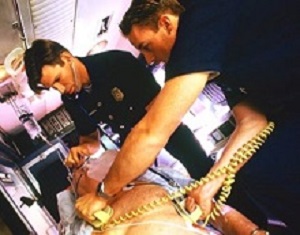 A study led by researchers at the University of Warwick suggests that people are reluctant to use public access defibrillators to treat cardiac arrests. The analysis of existing international studies suggests that there are a number of factors that prevent members of the public from using them and potentially saving lives.
A study led by researchers at the University of Warwick suggests that people are reluctant to use public access defibrillators to treat cardiac arrests. The analysis of existing international studies suggests that there are a number of factors that prevent members of the public from using them and potentially saving lives.
The researchers' study suggests that many members of the public don't know what an automated external defibrillator (AED) is, where to find one and how to use one. This is despite AEDs being suitable for use by untrained members of the public. Although studies suggest there is variation across the studies they analysed in the number of people willing to use an AED a lack of confidence and fear of harm are common themes.
The research was conducted by Warwick Medical School, the University of Warwick; the Institute of Digital Healthcare, WMG, the University of Warwick; Heart of England NHS Trust, Birmingham; London Ambulance Service NHS Trust and Imperial College Neurotrauma Centre, St Mary's Hospital, London.
Gavin Perkins, professor in critical care medicine at Warwick Medical School said: "Public access defibrillation is very effective in certain cases of cardiac arrest outside of hospital.
"A study conducted in the US showed that the chance of survival was nearly double in the group that received CPR and were treated with a public access defibrillator compared to the group that received CPR alone. However, the number of cases when a public access defibrillator is used is very low – just 0.15-4.3% of cardiac arrests that occur outside of hospitals."
Although only a minority of out of hospital cardiac arrests occur in locations where use of a defibrillator would help save a life AEDs are often poorly accessible or have limited availability; often their location is not known to even emergency services or those running training schemes. They also found that although members of the public saw the value of AED training most hadn't undergone training.
Theo Arvanitis, professor of e-health innovation and head of research at the Institute of Digital Healthcare, WMG, at the University of Warwick said: "Investment in more AEDs is great but it's at least as important to maximise use of existing defibrillators. "Many cardiac arrests that happen in public occur out of 'normal business hours' therefore if an AED is kept in a building there is a good chance the building won't be accessible. We would also like to see the message put out that these devices can be used without training. However our study found that those with training were more likely to use an AED so training is important too."
It was found that public-access AEDs were often acquired by donation or fundraising rather than private purchase, and donation was a predictor of AED acquisition among college athletic departments in one study.
The research team also examined the reasons for not obtaining an AED. They were: cost; concerns about liability; not being thought/not being considered necessary; lack of and/or attrition of responsible individuals; there was a good, local emergency service and there was a nearby hospital. One study reported that while 32% cited cost and 37% cited legal concerns as reasons not to obtain an AED, 55% thought affordability and 51% thought legal protection were good reasons to obtain an AED.
They also highlighted that maintenance of AEDs was variable. One study reported that all but one of 206 AEDs were “operable” and ready for use, but many AEDs were not maintained or had no formal plans in place for maintenance or replacement.
The systematic review conducted by the research team consisted of an analysis of 68 English language articles. Many of these were observational, many collected data retrospectively or were surveys. Due to the nature of the articles surveyed the team recommend further research is needed before making policy proposals.
Abstract
Public access defibrillation initiatives make automated external defibrillators available to the public. This facilitates earlier defibrillation of out-of-hospital cardiac arrest victims and could save many lives. It is currently only used for a minority of cases. The aim of this systematic review was to identify barriers and facilitators to public access defibrillation. A comprehensive literature review was undertaken defining formal search terms for a systematic review of the literature in March 2017. Studies were included if they considered reasons affecting the likelihood of public access defibrillation and presented original data. An electronic search strategy was devised searching MEDLINE and EMBASE, supplemented by bibliography and related-article searches. Given the low-quality and observational nature of the majority of articles, a narrative review was performed. Sixty-four articles were identified in the initial literature search. An additional four unique articles were identified from the electronic search strategies. The following themes were identified related to public access defibrillation: knowledge and awareness; willingness to use; acquisition and maintenance; availability and accessibility; training issues; registration and regulation; medicolegal issues; emergency medical services dispatch-assisted use of automated external defibrillators; automated external defibrillator-locator systems; demographic factors; other behavioural factors. In conclusion, several barriers and facilitators to public access defibrillation deployment were identified. However, the evidence is of very low quality and there is not enough information to inform changes in practice. This is an area in urgent need of further high-quality research if public access defibrillation is to be increased and more lives saved.
Authors
Christopher M Smith, Sarah N Lim, Choi Keung, Mohammed O Khan, Theodoros N Arvanitis, Rachael Fothergill, Christopher Hartley-Sharpe, Mark H Wilson, Gavin D Perkins
[link url="https://www2.warwick.ac.uk/newsandevents/pressreleases/people_are_reluctant/"]University of Warwick material[/link]
[link url="https://academic.oup.com/ehjqcco/article/3977882/Barriers-and-facilitators-to-public-access?searchresult=1"]European Heart Journal: Quality Care & Clinical Outcomes abstract[/link]
